by R.K. Campbell | Contributing Editor
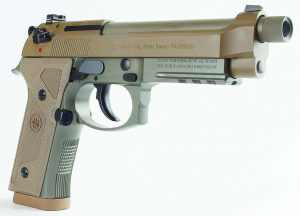
The Beretta A3 features a threaded barrel, Vertec grip, accessory rail and other modern features. These include a light rail, a solid feature that is demanded on modern combat pistols. The new frame has a stippling design along with grips designed to enhance both abrasion and adhesion.
The military is once again making noises concerning a new sidearm for the armed forces. Once again the trials or, more correctly, the circular that the military has tasked handgun makers with is inciting controversy. Handguns, for whatever reason, seem to come with more emotional attachment and a sense of history than the rifle. I agree that as a close quarters combat pistol the Beretta 92 is lacking the single most important attribute a sidearm should have and that is wound potential. The 9mm Luger cannot equal the wound potential of the .45 ACP. There is a lot of junk science in the world and I choose to ignore it, as will most professional soldiers and peace officers.
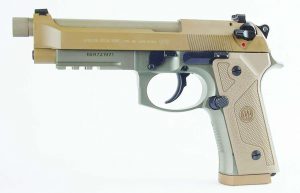
Left side of the Beretta A3, the latest in a long line of 9mm Beretta military handguns.
You cannot change the laws of physics: the big bullet does more damage. There is much to be said for the military simply ordering the pistols they need without going through a cumbersome trial period. Congressional oversight is all well and good; after all, it is our tax money—as if congress has a good record for spending our money—but the military should know their needs best. The pistol should be vetted in an exhaustive trial but that isn’t that difficult. All it takes is time, personnel and ammunition. But the Beretta A3 isn’t a new pistol. It is a modified Beretta M9/M92.
Sen. John McCain (R-AZ) felt that the Army should choose the caliber first. From his report, “The Army plans to conduct ‘an open caliber competition,’ which means the choice of caliber is left up to the discretion of industry. But the caliber of the cartridge and the type of bullet it launches is arguably the most important performance component of the handgun,” the report states.
Army officers have made comments such as ‘just buy a bunch of Glock 19 9mm pistols:’ another reasonable trend.
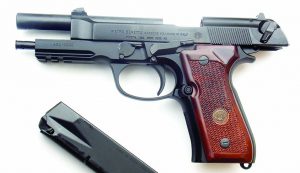
The author’s Italian 92A1’s most obvious departure from the Beretta 92 is the light rail.
However, there are certain requirements in the new Army circular for the MHS pistol (Army Modular Handgun System) that cannot be met by many pistols, but which may be met by the Beretta A3. The A3 is, of course, simply an updated Beretta 92. That isn’t a bad thing as the Beretta’s primary advantage is reliability. It is also accurate enough for any foreseeable handgun task. The requirement for a capability to use a suppressor in certain roles, by certain teams, is easily met by the A3’s threaded barrel. This barrel may also be retrofitted to existing Beretta 9mm pistols easily. The pistol may also be supplied with Tritium inserts if need be. The pistol also is delivered with a light rail for use with lasers or combat lights. Other handguns may also have this feature as standard.
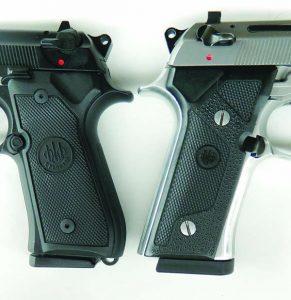
The Vertec grip, right, results in a considerably better hand fit for most hand sizes.
A big advantage is that the pistol features the “Vertec” type grip. This grip has been offered by Beretta on several pistols.It is a thinner grip that allows those with small hands to use the pistol well. A high capacity pistol isn’t always tolerant of small hand sizes. The Beretta features a double-action first shot trigger. The trigger is pressed to fire the pistol and then the hammer is cocked by the recoiling slide for subsequent single-action fire. The safety lever also operates as a decocking lever. The Army wants a manual safety. I agree. A pistol without a safety abrogates many of the advantages of a self-loading pistol.
The Beretta is easy enough to fire well with light recoil and modest muzzle flip. Tactically there is nothing that may be done with the SIG P 226 or the Glock 17 that cannot be done with the Beretta. In long range and slow fire accuracy, the Beretta is superior to most pistols save perhaps the SIG but it takes a fine shot to demonstrate this. The new Beretta pistol will be able to use existing holsters, magazines and spare parts in stock for the Beretta 92. Those using tightly molded personal holsters will have to order a new holster to accommodate the Beretta’s frame. Of course ammunition supply isn’t impeded.
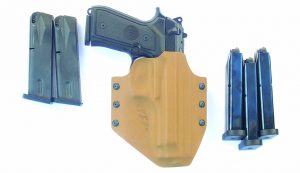
This M9 is carried in a ZZZ Custom Kydex holster. Five magazines include two 15 round and three 17 round magazines for a total of 81 rounds of ammunition—a lot of firepower!
The Beretta A3 is a good upgrade over Beretta 92 and Beretta 92A1 pistols. It will serve the Army’s needs well. This is simple reality. As for myself I will continue to carry a big bore 1911 handgun cocked and locked. I could make a considerable case for the reliability and longevity of the 1911 .45 and I have done so in several books on the 1911.
The problem is training. The Army trains their men but little with the handgun. It isn’t unusual for the average soldier to go for years without firing the handgun past an initial familiarization in training. The Beretta has a good safety record and it is easy enough use well. As for its competitors we don’t really know what their performance would be like in the sandbox. We can predict that it is an even bet with certain types of pistols—AO types without a safety—there would be more negligent discharges. Perhaps a lot more! Beretta fans will be pleased and Colt 1911 fans will have to bite the bullet and let the deal go ahead without undue rancor. I would personally prefer the Colt 1911 .45. The SIG P 227 .45 is completely attractive on every count and would make a fine service pistol, but it is unlikely it will be chosen.
As for training the soldiers, there are certain select teams in the US Military that fire many thousands of rounds in the handgun on a yearly basis. These teams are well equipped and highly trained. Those that need the 1911 .45 and prefer the pistol will obtain one. The Marine Corps, as an example, uses the Colt 1911 Rail Gun for special operations groups. If the Army is going to continue with the 9mm High Capacity pistol, the Beretta A3 is as good as any and better than many.



